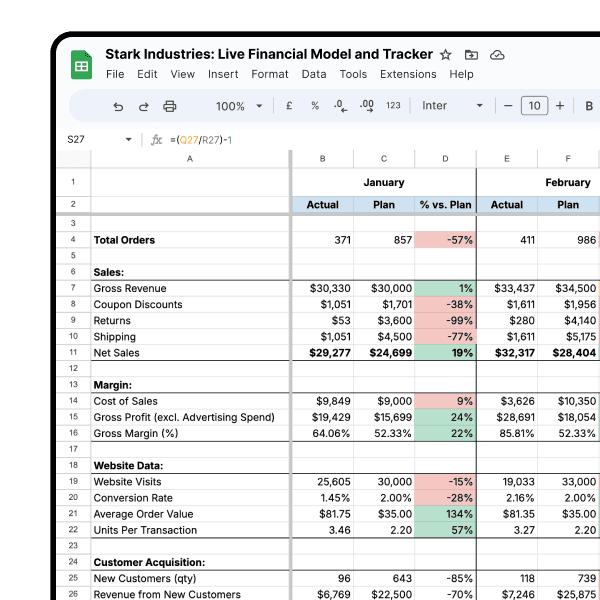Reporting & Analysis
Aug 22, 2023
TLDR
To determine cross-sell opportunities, examine purchase history, browsing behavior, customer demographics, and feedback. Follow these steps: collect data using suitable tools, segment your customers, identify top-selling and underperforming products, analyze purchase patterns, and review feedback. Implement strategies like personalized product recommendations, enticing product bundles, optimized website UX, and targeted email marketing. Monitor key indicators like average order value, conversion rate, returning customers, and customer satisfaction. Continuously refine your tactics to adapt to evolving market trends and customer preferences.
Direct-to-consumer businesses are extremely competitive today, data-driven decision-making is paramount. Every interaction on your site offers insights, guiding your business's growth trajectory. Cross-selling, when anchored in data analysis, can significantly increase sales by presenting customers with precisely what they need. Ultimately, it would lead to an increased customer lifetime value.
Before deciding on your cross selling strategy, first review the data at your disposal and uncover insights to guide you in making the right decisions. This guide will walk you through the process of how to make the most of your store data to inform your strategy planning.
Types of data to consider
When reviewing your store data, there are four types of metrics you should look at:
a. Purchase History
This data provides insights into what products are popular, which ones are often bought together, and the frequency of repeat purchases. It's a goldmine for understanding customer preferences and spotting trends.
b. Browsing Behavior
Beyond purchases, the way customers navigate your site, the products they view, and the time they spend can offer invaluable insights. This can help you identify potential products for cross-selling and understand the customer journey.
c. Customer Demographics
Age, location, gender, and other demographic data can provide context to buying behaviors, helping you segment your audience and tailor your cross-selling strategies accordingly.
d. Customer Feedback
Reviews, feedback forms, and direct communications are direct windows into your customers' minds. They can highlight gaps in your product range, suggest potential complementary products, and even indicate how receptive your audience might be to cross-selling initiatives.
Your store data is not just a record of past transactions; it's a roadmap to future opportunities. To get the most out of your store data, you need to analyze it well.
Steps to effectively analyze your store data
To ensure that your cross-selling strategies are both targeted and impactful, these are the steps you need to take for data analysis:
a. Collect your data
Tools and Platforms: In today's digital landscape, there are numerous tools and platforms available to facilitate data collection. From Google Analytics to specialized e-commerce platforms like Shopify, it's essential to choose tools that align with your business needs and scale. These tools can automatically gather data on user behavior, sales trends, and more.
Ensuring Data Accuracy and Consistency: The integrity of your data is paramount. Regular audits, ensuring proper tracking setups, and cross-referencing data sources can help maintain accuracy. Using a third party tool like Airboxr to compare data across platforms, particularly for performance marketing, helps to bring clarity to your analysis.
b. Segment your customers
Understanding your audience in segments rather than as one big group yields more targeted insights.
Based on Purchase History: Group customers by their purchase frequency, the product categories they prefer, or their average order value.
Try Airboxr's Buyers by SKU Hop for a list of customers who purchased individual products.
Try Airboxr's Most Valuable Customers Hop for a complete list of all your customers, ranked by recency, frequency, and monetary value.
Based on Behavior: Consider segmenting users who abandon carts, those who frequently visit but never purchase, or those who consistently engage with certain product pages.
Based on Demographics: Age, location, and other demographic factors can significantly influence buying behavior. Segmenting by these criteria can offer insights into which products might appeal to different customer groups.
Try Airboxr's Customers by Location Hop for an aggregate of customer locations, no. of orders, and total order value.
Try Airboxr's Order Export Hop and filter by shipping country or city for a list of customers from a certain location.
c. Identify top-selling and underperforming products
By analyzing sales data, you can pinpoint which products are your star performers and which might need a boost. This knowledge is crucial for effective cross-selling. For instance, pairing a top-seller with underperforming but related or complementary items can elevate sales on both ends.
Try Airboxr's Product Sales Performance Hop for a list of products by their sales volume.
d. Analyzing customer purchase patterns
Dive deep into transaction histories to discern patterns. Are certain products frequently bought together? Are there seasonal trends in purchases? Such insights can guide your cross-selling strategy, ensuring it resonates with observed customer behavior.
Try Airboxr's Frequently Bought Together Hop to identify items often purchased in the same cart.
Try Airboxr's Cross-Sell Analysis Hop to identify items purchased after a particular SKU.
e. Reading customer feedback and reviews
Reviews can highlight product gaps, suggest complementary items, or even indicate the overall market reception of your cross selling promotions.
Improve your DTC game. Sign up for weekly tips.
Implementing cross-selling strategies based on data insights
With a robust understanding of your store data now at your fingertips, it's time to translate these insights into actionable steps. These strategies should not only boost sales, but also enhance the overall customer experience. Let's explore the most effective ways to achieve this.
a. Personalized product recommendations
Techniques for Tailoring Product Suggestions: Harness the power of algorithms and machine learning to offer product recommendations that resonate with individual customer preferences. For instance, if an existing customer frequently purchases athletic wear, suggesting complementary sports accessories can be a winning move.
Importance of Real-Time Personalization: In the dynamic world of e-commerce, real-time data is invaluable. Adjust product recommendations based on real-time browsing behavior, ensuring that your suggestions are always relevant and timely.
b. Creating attractive product bundles
Designing Bundles: Use the insights from your data analysis to create product bundles that make sense. If your data shows that customers often buy a camera and a tripod together, offer them as a discounted bundle.
Pricing Strategies: Price your bundles in a way that offers perceived value. The discount on a bundle should be enticing enough to encourage the purchase of multiple products together.
c. Optimizing website and user experience
Strategically Placing Cross-Sell Opportunities: Integrate cross-selling prompts at key touchpoints – product pages, checkout processes, and even the cart page. For instance, when a customer adds a laptop to their cart, prompt them with compatible accessories.
Enhancing Website Navigation: Ensure that your website is intuitive and user-friendly. A seamless browsing experience can significantly boost the effectiveness of your cross-selling efforts.
d. Email marketing and retargeting ads
Crafting Targeted Emails: Use the power of email marketing to remind existing customers of complementary products. For instance, if a customer recently purchased a grill, a follow-up email showcasing grilling accessories can be effective.
Using Retargeting Ads: Retargeting ads can be a potent tool for cross-selling. If a customer viewed a product but didn't purchase, retargeting them with ads showcasing complementary products can reignite their interest and lead to a sale.
Monitoring and adjusting your cross-selling strategies
The journey doesn't end once you've implemented your cross-selling strategies. In the ever-evolving landscape of e-commerce, continuous monitoring and adjustment are paramount to ensure sustained success. Let's delve into how you can effectively measure the impact of your strategies and make necessary refinements.
Key Performance Indicators (KPIs) to evaluate success
Average Order Value (AOV): One of the primary goals of cross-selling is to increase the AOV. Monitor this metric to gauge the immediate impact of your cross-selling efforts.
Conversion Rate: Track how often cross-sell prompts lead to an actual purchase. A low conversion rate might indicate that the recommended products aren't resonating with the customers.
Rate of Returning Customers: Effective cross-selling can lead to increased customer loyalty. Monitor the frequency of return customers as an indicator of the success of your strategies.
Customer Satisfaction: Use post-purchase surveys and feedback forms to understand how customers perceive your cross-selling efforts. Are they finding value in the recommendations, or do they feel overwhelmed?
Importance of continuous refinement
Adapting to Changing Trends: Consumer preferences and market trends are not static. Regularly review your cross-selling strategies to ensure they align with current market dynamics.
Iterative Testing: Consider A/B testing different cross-selling techniques to determine what resonates most with your audience. For instance, test different product bundles or placement of cross-sell prompts on your website.
Feedback Loop: Encourage customer feedback specifically on your cross-selling efforts. Direct insights from your audience can offer invaluable guidance on areas of improvement.
Now that you have this playbook for boosting sales through cross-selling, it's time to put your new marketing strategy into action. We can't wait to see how you do.


